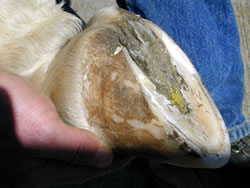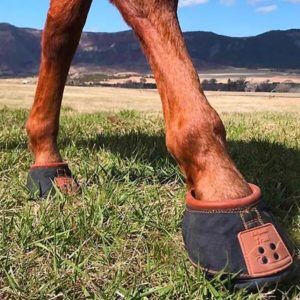Customer Question:
My farrier is very conscientious and appears well trained with recent schooling. I’m puzzled by the fact that he trims the frog and some of the sole of the hoof. I ride my horse a lot, sometimes on gravel or stony roads. Doesn’t my horse need all that frog and hoof thickness? He avoids rocky sections of the road whenever possible in favor of the grassy edges.
Veterinarian’s Answer:
Updated from original post in 2009, Dr. Joyce Harman of Harmany Equine Clinic in Flint Hill, Virginia, provides a great answer to this question.
 There are many different schools of thought about horseshoeing and trimming the barefoot horse. I feel it is very important that you, the owner, learn as much as possible about your barefoot horse, so you can take responsibility for making decisions about hoof care.
There are many different schools of thought about horseshoeing and trimming the barefoot horse. I feel it is very important that you, the owner, learn as much as possible about your barefoot horse, so you can take responsibility for making decisions about hoof care.
The purpose of the hoof wall is to protect the coffin bone, to provide support for the body, and renew itself as it wears down. It needs to be strong, flexible, and a correct shape. The shape can vary a bit depending on the horse’s conformation, but in reality, well-trimmed feet are fairly similar in shape, with a short toe, strong heels, a large frog, and strong bars. Having said that, there are horses that have very poorly shaped feet, or that have very different shaped feet no matter how well trimmed they are.
In most cases, it is not necessary nor desirable to trim away frog and live sole, but it is commonly done. The foot needs the full shape of the frog to help with expansion, contraction, and blood flow. The sole is there for protection from the ground. The only trimming needed on the sole is to remove flaky, dead sole. Any live sole that does not flake away easily should be left for the horse.
Even more important is the sole callus, the thicker band of sole that goes across the toe area. This callus provides support to the inside of the foot (the laminae that connect the hoof wall to the coffin bone) and should never be cut off.
Finally, the toes should be short enough that the horse can roll over his toes easily. A common fault in shoeing is leaving the toes too long, whether the horse is barefoot or shod.
Many people are learning to trim their own horse’s feet, which is good if you get training and always continue learning. Do not fall into the trap of thinking that every horse’s feet can be made the same or trimmed the same way.
 Also, it is not fair nor humane to the horse to remove the shoes and leave him sore for the next year or so while his feet grow out. Easyboots will make a huge difference in your horse’s comfort level through this transition. Whether your horse needs protection only when he’s out of his stall/pasture, or whether he needs constant cushioning and protection, EasyCare has the solution.
Also, it is not fair nor humane to the horse to remove the shoes and leave him sore for the next year or so while his feet grow out. Easyboots will make a huge difference in your horse’s comfort level through this transition. Whether your horse needs protection only when he’s out of his stall/pasture, or whether he needs constant cushioning and protection, EasyCare has the solution.





